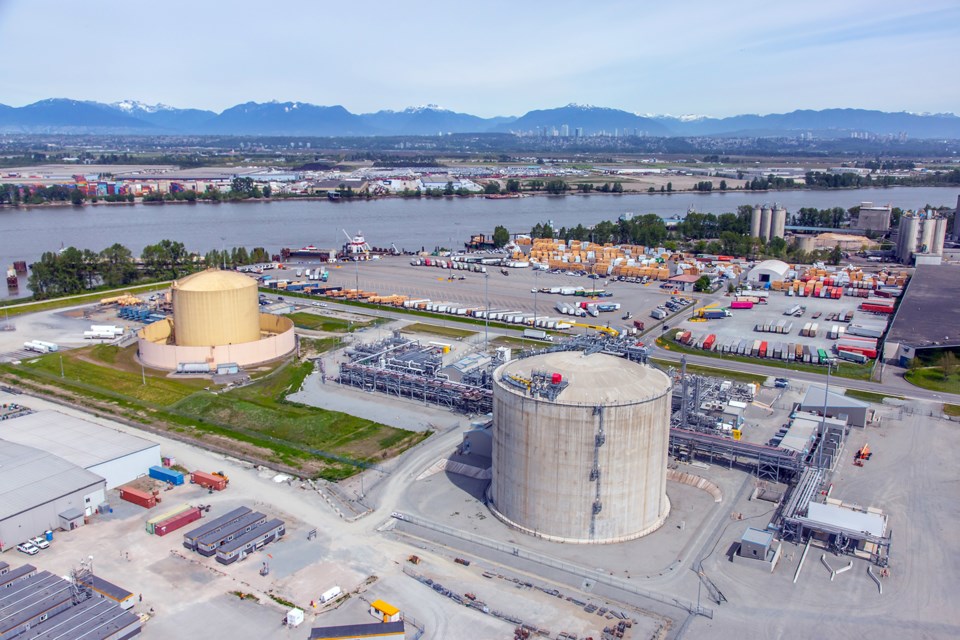The Boundary Bay Conservation Committee is raising alarm about an application by FortisBC to amend its air quality permit to increase its maximum permitted sulphur dioxide emissions eight-fold at the Tilbury liquefied natural gas (LNG) plant in Delta.
Noting the application to amend its Metro Vancouver air quality permit to increase emissions from 3.4 tonnes per year to 28 tonnes per year would lead to an increase in sulphur dioxide emissions into the Greater Vancouver airshed, the BBCC’s Susan Jones in a letter to the regional district, said the proposal does not provide detailed project information to inform the public of the ongoing and long-term effects of such an increase.
She noted the application does not disclose that it’s just the beginning as FortisBC is planning further expansions, including increases to 13,700 tonnes of LNG per day, making it a massive, full-scale plant 1.4 times the size of the Woodfibre LNG plant.
“The public should be explicitly informed that the plan is to produce and export LNG with LNG vessels on the Fraser River and through the Salish Sea. The plan of locating such a large-scale LNG plant so close to residential communities and nearby commercial and industrial operations jeopardizes human health and safety, as well as the globally-significant ecosystems of the Fraser River and Salish Sea. The Project, on the narrow winding Fraser River close to communities, does not meet international safety standards. Ongoing incremental increases in pollution for an agenda that is not fully disclosed fail transparency of process,” said Jones.
FortisBC has stated that 28 tonnes is the maximum emissions possible and they don’t expect to ever reach that amount. The utility also had a temporary permit to emit 160 tonnes per year but they never went anywhere near that amount and have since changed the technology they use.
FortisBC is required to compile a report that estimates how much will be released and where it will be dispersed, a report forwarded for assessment by Fraser Health.
“The amendment would allow the facility to operate as it was designed by removing impurities such as sulphur compounds during production. The removal of impurities enables our facility to produce LNG with some of the lowest carbon intensity in the world,” according to the utility.
However, Jones noted it’s not in the public interest to grant a permit for emissions that FortisBC states will not occur, adding it opens the door for future increases in emissions, which are inevitable with extensive expansions plans.
“As high levels of sulphur dioxide emissions are toxic to human health, it is in the public interest to ensure permits are explicit and do not contribute to ongoing increases that cumulatively raise pollution levels in the Great Vancouver airshed,” she said.
A Delta staff memo to city council on the issue notes Metro Vancouver requires applicants to use appropriate emission control technology and minimize and avoid emissions as much as possible.
The regional district has confirmed that the technology being used by FortisBC in this case is considered the best available control technology for sulphur dioxide emissions.
“Regarding air quality generally, it is noted that ongoing monitoring by Metro Vancouver has shown that most air contaminant levels have been reduced over the last decade, even while the region’s population has grown. Sulphur dioxide levels in Delta are approximately 10 times less than the Metro Vancouver air quality objective and the overall regional concentration of sulphur dioxide has reduced 80 per cent from 2008 levels, primarily due to the reduction of sulphur content in marine fuels and the switch to LNG as a marine fuel,” the staff response notes.
FortisBC currently has an application for its Phase 2 Expansion at Tilbury, which proposes to add 162,000 cubic metres of additional LNG storage and up to 3.5 million tonnes of LNG liquefaction capacity per year.
The total LNG storage at the Tilbury LNG facility, which has operated since 1971 without serious incidents, could end up at 236,000 cubic metres once the expansion is completed.


